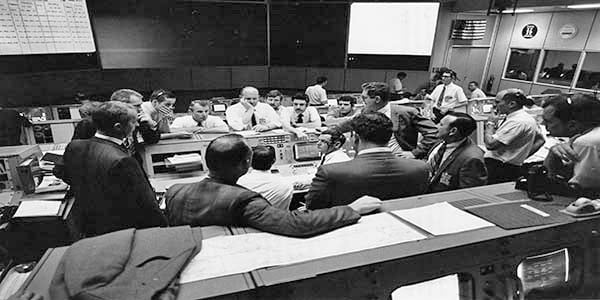Crisis Management Lessons from Apollo 13

A crisis can hit at any time, and a leader’s role is to be agile and successfully lead the organization. In the midst of the current COVID-19 crisis, we pause to mark the 50th anniversary of the Apollo 13 explosion. The details of the inspiring rescue mission provide a powerful case study with three key lessons to help today’s leaders be agile and guide their businesses through a crisis.
On April 13, 1970, Apollo 13 was 56 hours into its flight when an oxygen tank explosion forced the crew to abandon its plan to reach the moon. When astronaut Jim Lovell said the now-famous words, “Houston, we’ve had a problem,” the Apollo 13 astronauts and NASA’s Mission Control – its leadership core – began navigating through a serious crisis.
In times of crisis, leadership must quickly adapt. With the Apollo 13 explosion, NASA faced the possibility of astronaut death and severe damage to the American space program. But, through agile leadership, Mission Control turned the Apollo 13 crisis into a successful rescue mission with all three astronauts safely returning to Earth.
Lesson 1: Establish the Urgent Priority
Shortly after the explosion, Flight Director Gene Kranz made it clear to the astronauts and all of Mission Control that Apollo 13 was no longer a lunar landing mission. It was a rescue mission.
In Houston, Kranz drew two circles on a blackboard – the Earth and the moon. He drew a figure-eight-like loop connecting the two and explained that Apollo 13 would loop around the moon and use its gravity to get back to Earth. He pointed to the spacecraft’s current location and then to where it would re-enter the Earth’s atmosphere.
“They’re here and we need to get them here,” Kranz said.
The message was very clear. With his simple drawing, Kranz clearly communicated the new priority of the mission. He ensured that everyone focused on the same goal.
When you face a crisis, you must quickly pivot to establish and communicate the new priority addressing the crisis and seeking its resolution.
Ask yourself: What do you need to prioritize to stay in business and still be viable when the crisis ends?
Lesson 2: React with Responsive Innovation
The explosion badly damaged the fuel cells that provided electricity and water to the astronauts. Additionally, oxygen was leaking into space from the command module — the main part of the spacecraft.
Within a few hours of the explosion, the command module could no longer supply the necessary oxygen, water, or electricity. The astronauts had to react with responsive innovation. They worked quickly to convert the lunar module into their new home. The lunar module was designed to take two astronauts to the surface of the moon. It wasn’t built to support three men for 90 hours. But, adapting the lunar module was the responsive innovation necessary for survival.
Dick Richardson, a member of the WDHB Advisory Board, said in his book, Apollo Leadership Lessons, “Innovation is about introducing change into an already existing system or process.” Innovation is not free-flowing ideas of creativity. Instead, innovation is measurable and practical. In a crisis, use innovation as a practical reaction within the boundaries of your company’s resources — this is responsive innovation.
When a crisis strikes, you must maximize your business’s capabilities within the boundaries of its resources. When the command module was failing, Flight Director Gene Kranz asked his team, “what do we got [sic] on the spacecraft that’s good?” He focused on using the resources available in new and innovative ways to achieve the goal. Mission Control used responsive innovation by turning the Apollo 13 lunar module into a lifeboat for its crew.
Ask yourself: What resources does your company have and how can you innovate to respond to the crisis at hand?
Lesson 3: Through it all, Give Clear Communication
Once the Apollo 13 astronauts powered up the lunar module, they worked with Mission Control to change their flight path. The explosion had severely damaged the calculation equipment. Therefore, these precise course corrections were calculated by Mission Control and communicated to the astronauts to implement.
At one point, Mission Control innovated around the equipment loss by directing the Apollo 13 crew to use the sun for aligning a platform. Flight Director Gerald Griffin recalled, “the people involved knew how important it was to have that platform properly aligned.” Mission Control needed to give the crew clear and constant communication so they could steer their spacecraft home.
Once leaders establish priorities and use responsive innovation in a crisis, they must clearly communicate their crisis response plans. Employees and customers must be part of the solution through transparent, consistent communication.
Ask yourself: During a crisis, how can you make communication very clear? Have you put a crisis communication plan in place?
You Can Thrive After a Crisis
As the Apollo 13 crew prepared to re-enter Earth’s atmosphere, they released the damaged command module. As it drifted away, they saw the extent of the explosion’s damage.
A company crisis can leave extensive damage too — lost income, laid-off employees, or a negative impact on the company’s reputation. But, as we reflect on the Apollo 13 mission, we see that NASA leaders’ focused and responsible reaction resulted in saved lives and even boosted the organization’s reputation.
The crisis will end. To what extent a company survives the crisis and thrives afterward is largely based on how well leaders refocus company priorities, respond with innovation, and clearly communicate to employees and customers.
Now, more than ever, leaders and businesses must be agile and responsive. Want more information on leading through a crisis? Contact us to discuss your specific needs and challenges.
Author
Subscribe to get Access to Exclusive Content





